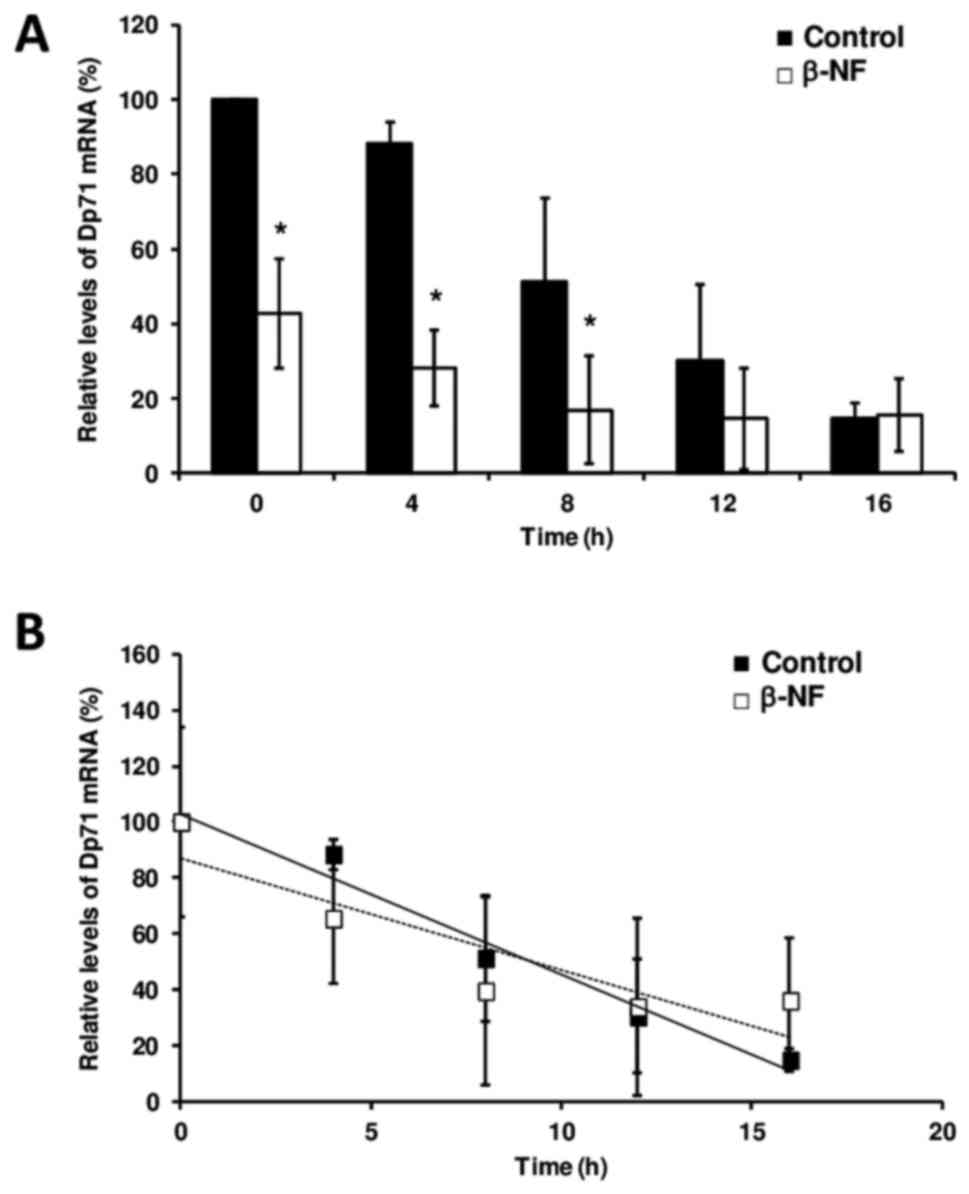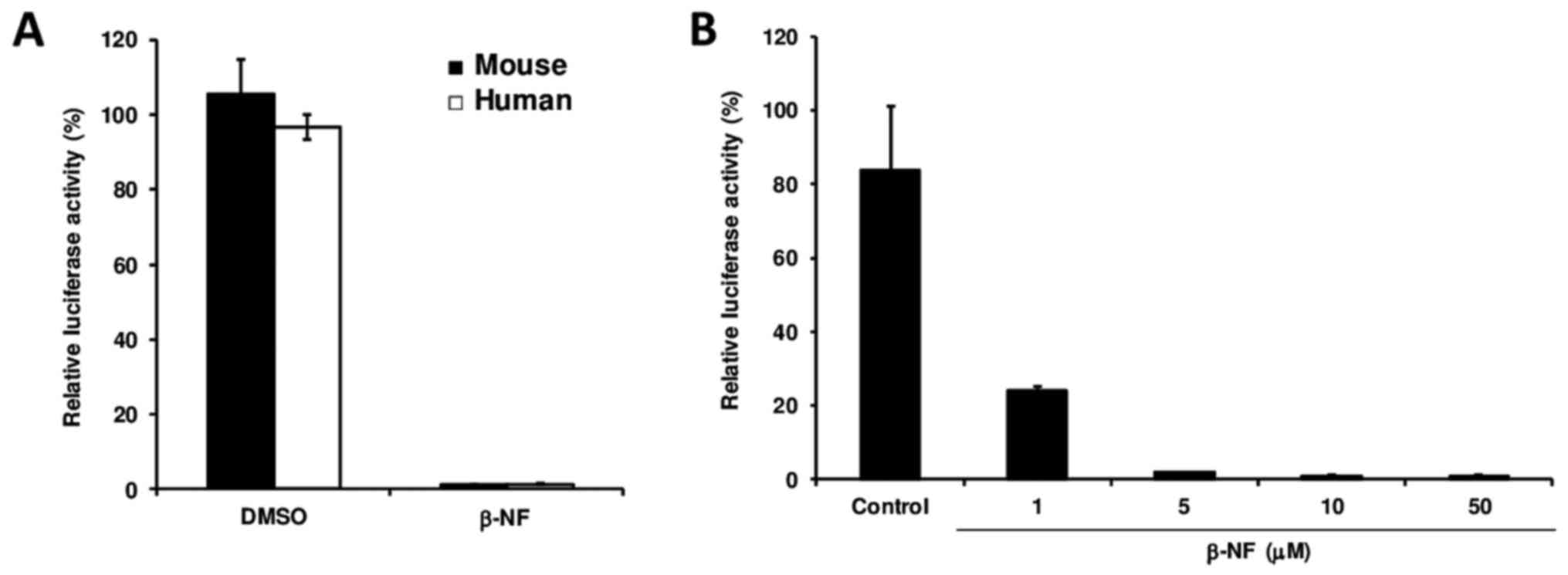|
1
|
Ahn AH and Kunkel LM: The structural and
functional diversity of dystrophin. Nat Genet. 3:283–291. 1993.
View Article : Google Scholar : PubMed/NCBI
|
|
2
|
Koenig M, Monaco AP and Kunkel LM: The
complete sequence of dystrophin predicts a rod-shaped cytoskeletal
protein. Cell. 53:219–228. 1988. View Article : Google Scholar : PubMed/NCBI
|
|
3
|
Bar S, Barnea E, Levy Z, Neuman S, Yaffe D
and Nudel U: A novel product of the Duchenne muscular dystrophy
gene which greatly differs from the known isoforms in its structure
and tissue distribution. Biochem J. 272:557–560. 1990. View Article : Google Scholar : PubMed/NCBI
|
|
4
|
Byers TJ, Lidov HG and Kunkel LM: An
alternative dystrophin transcript specific to peripheral nerve. Nat
Genet. 4:77–81. 1993. View Article : Google Scholar : PubMed/NCBI
|
|
5
|
D'Souza VN, Nguyen TM, Morris GE, Karges
W, Pillers DA and Ray PN: A novel dystrophin isoform is required
for normal retinal electrophysiology. Hum Mol Genet. 4:837–842.
1995. View Article : Google Scholar : PubMed/NCBI
|
|
6
|
Lidov HG, Selig S and Kunkel LM: Dp140: A
novel 140 kDa CNS transcript from the dystrophin locus. Hum Mol
Genet. 4:329–335. 1995. View Article : Google Scholar : PubMed/NCBI
|
|
7
|
Greenberg DS, Schatz Y, Levy Z, Pizzo P,
Yaffe D and Nudel U: Reduced levels of dystrophin associated
proteins in the brains of mice deficient for Dp71. Hum Mol Genet.
5:1299–1303. 1996. View Article : Google Scholar : PubMed/NCBI
|
|
8
|
Hugnot JP, Gilgenkrantz H, Vincent N,
Chafey P, Morris GE, Monaco AP, Berwald-Netter Y, Koulakoff A,
Kaplan JC, Kahn A, et al: Distal transcript of the dystrophin gene
initiated from an alternative first exon and encoding a 75-kDa
protein widely distributed in nonmuscle tissues. Proc Natl Acad Sci
USA. 89:pp. 7506–7510. 1992; View Article : Google Scholar : PubMed/NCBI
|
|
9
|
Greenberg DS, Sunada Y, Campbell KP, Yaffe
D and Nudel U: Exogenous Dp71 restores the levels of dystrophin
associated proteins but does not alleviate muscle damage in mdx
mice. Nat Genet. 8:340–344. 1994. View Article : Google Scholar : PubMed/NCBI
|
|
10
|
Cox GA, Sunada Y, Campbell KP and
Chamberlain JS: Dp71 can restore the dystrophin-associated
glycoprotein complex in muscle but fails to prevent dystrophy. Nat
Genet. 8:333–339. 1994. View Article : Google Scholar : PubMed/NCBI
|
|
11
|
Sarig R, Mezger-Lallemand V, Gitelman I,
Davis C, Fuchs O, Yaffe D and Nudel U: Targeted inactivation of
Dp71, the major non-muscle product of the DMD gene: Differential
activity of the Dp71 promoter during development. Hum Mol Genet.
8:1–10. 1999. View Article : Google Scholar : PubMed/NCBI
|
|
12
|
Lambert M, Chafey P, Hugnot JP, Koulakoff
A, Berwald-Netter Y, Billard C, Morris GE, Kahn A, Kaplan JC and
Gilgenkrantz H: Expression of the transcripts initiated in the 62nd
intron of the dystrophin gene. Neuromuscul Disord. 3:519–524. 1993.
View Article : Google Scholar : PubMed/NCBI
|
|
13
|
Acosta R, Montanez C, Fuentes-Mera L,
Gonzalez E, Gómez P, Quintero-Mora L, Mornet D, Alvarez-Salas LM
and Cisneros B: Dystrophin Dp71 is required for neurite outgrowth
in PC12 cells. Exp Cell Res. 296:265–275. 2004. View Article : Google Scholar : PubMed/NCBI
|
|
14
|
Enríquez-Aragón JA, Cerna-Cortès J,
Bermúdez de León M, García-Sierra F, González E, Mornet D and
Cisneros B: Dystrophin Dp71 in PC12 cell adhesion. Neuroreport.
16:235–238. 2005. View Article : Google Scholar : PubMed/NCBI
|
|
15
|
Tadayoni R, Rendon A, Soria-Jasso LE and
Cisneros B: Dystrophin Dp71: the smallest but multifunctional
product of the Duchenne muscular dystrophy gene. Mol Neurobiol.
45:43–60. 2012. View Article : Google Scholar : PubMed/NCBI
|
|
16
|
Villarreal-Silva M, Centeno-Cruz F,
Suàrez-Sànchez R, Garrido E and Cisneros B: Knockdown of dystrophin
Dp71 impairs PC12 cells cycle: Localization in the spindle and
cytokinesis structures implies a role for Dp71 in cell division.
PLoS One. 6:e235042011. View Article : Google Scholar : PubMed/NCBI
|
|
17
|
de León MB, Montañez C, Gómez P,
Morales-Lázaro SL, Tapia-Ramírez V, Valadez-Graham V,
Recillas-Targa F, Yaffe D, Nudel U and Cisneros B: Dystrophin Dp71
expression is down-regulated during myogenesis: Role of Sp1 and Sp3
on the Dp71 promoter activity. J Biol Chem. 280:5290–5299. 2005.
View Article : Google Scholar : PubMed/NCBI
|
|
18
|
Peñuelas-Urquides K, Becerril-Esquivel C,
Mendoza-de-León LC, Silva-Ramírez B, Dávila-Velderrain J, Cisneros
B and de León MB: Transcription factors YY1, Sp1 and Sp3 modulate
dystrophin Dp71 gene expression in hepatic cells. Biochem J.
473:1967–1976. 2016. View Article : Google Scholar : PubMed/NCBI
|
|
19
|
Morales-Làzaro SL, Gonzàlez-Ramirez R,
Gòmez P, Tapia-Ramirez V, de León MB and Cisneros B: Induction of
dystrophin Dp71 expression during neuronal differentiation:
Opposite roles of Sp1 and AP2alpha in Dp71 promoter activity. J
Neurochem. 112:474–485. 2010. View Article : Google Scholar : PubMed/NCBI
|
|
20
|
Gerets HH, Tilmant K, Gerin B, Chanteux H,
Depelchin BO, Dhalluin S and Atienzar FA: Characterization of
primary human hepatocytes, HepG2 cells and HepaRG cells at the mRNA
level and CYP activity in response to inducers and their
predictivity for the detection of human hepatotoxins. Cell Biol
Toxicol. 28:69–87. 2012. View Article : Google Scholar : PubMed/NCBI
|
|
21
|
Volkov MS, Bolotina NA, Evteev VA and
Koblyakov VA: Ah-receptor-independent stimulation of hepatoma 27
culture cell proliferation by polycyclic aromatic hydrocarbons.
Biochemistry. 77:201–207. 2012.PubMed/NCBI
|
|
22
|
Bermúdez de Leòn M, Gómez P, Elizondo G,
Zatarain-Palacios R, García-Sierra F and Cisneros B:
Beta-naphthoflavone represses dystrophin Dp71 expression in hepatic
cells. Biochim Biophys Acta. 1759:152–158. 2006. View Article : Google Scholar : PubMed/NCBI
|
|
23
|
López-Terrada D, Cheung SW, Finegold MJ
and Knowles BB: Hep G2 is a hepatoblastoma-derived cell line. Hum
Pathol. 40:1512–1515. 2009. View Article : Google Scholar
|
|
24
|
Livak KJ and Schmittgen TD: Analysis of
relative gene expression data using real-time quantitative PCR and
the 2−ΔΔCT method. Methods. 25:402–408. 2001. View Article : Google Scholar : PubMed/NCBI
|
|
25
|
Schreiber E, Matthias P, Müller MM and
Schaffner W: Rapid detection of octamer binding proteins with
‘mini-extracts’, prepared from a small number of cells. Nucleic
Acids Res. 17:64191989. View Article : Google Scholar : PubMed/NCBI
|
|
26
|
Tennyson CN, Dally GY, Ray PN and Worton
RG: Expression of the dystrophin isoform Dp71 in differentiating
human fetal myogenic cultures. Hum Mol Genet. 5:1559–1566. 1996.
View Article : Google Scholar : PubMed/NCBI
|
|
27
|
Jokela TA, Makkonen KM, Oikari S, Kärnä R,
Koli E, Hart GW, Tammi RH, Carlberg C and Tammi MI: Cellular
content of UDP-N-acetylhexosamines controls hyaluronan synthase 2
expression and correlates with O-linked N-acetylglucosamine
modification of transcription factors YY1 and SP1. J Biol Chem.
286:33632–33640. 2011. View Article : Google Scholar : PubMed/NCBI
|
|
28
|
Tan NY and Khachigian LM: Sp1
phosphorylation and its regulation of gene transcription. Mol Cell
Biol. 29:2483–2488. 2009. View Article : Google Scholar : PubMed/NCBI
|
|
29
|
Chiba T, Chihara J and Furue M: Role of
the arylhydrocarbon receptor (AhR) in the pathology of asthma and
COPD. J Allergy. 2012:3723842012. View Article : Google Scholar
|
|
30
|
Nebert DW, Roe AL, Dieter MZ, Solis WA,
Yang Y and Dalton TP: Role of the aromatic hydrocarbon receptor and
[Ah] gene battery in the oxidative stress response, cell cycle
control, and apoptosis. Biochem Pharmacol. 59:65–85. 2000.
View Article : Google Scholar : PubMed/NCBI
|












